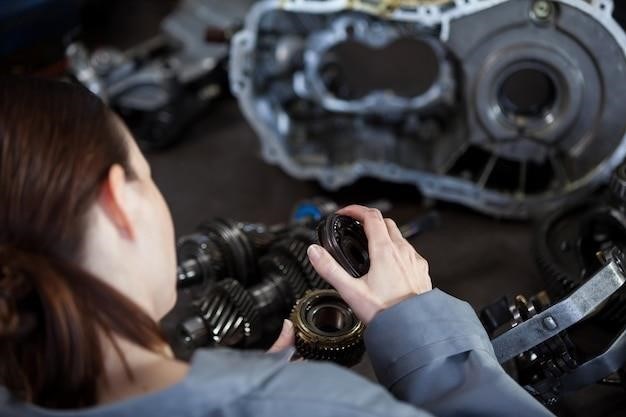This guide will cover the essential steps for swapping out your Chevy transmission, providing you with the knowledge and resources to successfully complete this popular modification․ From choosing the right transmission and identifying the necessary parts to troubleshooting common issues, we’ll walk you through the process step by step․ Whether you’re looking to upgrade to a more powerful transmission or simply replace a worn-out unit, this guide will provide you with the information you need to get the job done right․
Introduction
Swapping transmissions in Chevrolet vehicles is a popular modification among enthusiasts, offering numerous benefits such as increased performance, improved fuel economy, or simply replacing a worn-out transmission․ Whether you’re a seasoned mechanic or a DIY enthusiast, understanding the basics of a Chevy transmission swap is crucial for a successful outcome․ This guide will delve into the intricacies of this process, providing you with the knowledge to tackle this project confidently․
Chevrolet transmissions have a reputation for durability and reliability, but like any mechanical component, they can wear out over time․ A transmission swap might be necessary if you experience issues like slipping gears, rough shifting, or complete failure․ Additionally, swapping to a different transmission can unlock performance gains, allowing you to harness the full potential of your engine․
Before embarking on a transmission swap, it’s essential to carefully consider your goals and budget․ Research different transmission options available for your Chevy model, taking into account compatibility, performance characteristics, and cost․ A well-planned approach will minimize potential issues and ensure a smooth and successful swap․ This guide will provide you with the necessary information to make informed decisions throughout the process․
Choosing the Right Transmission
Selecting the right transmission for your Chevy swap is crucial for optimal performance and compatibility․ There are numerous options available, each with its own strengths and weaknesses․ Consider the following factors when making your decision⁚
- Year and Model of Your Vehicle⁚ Compatibility is key․ Check the interchange chart for your Chevy model to ensure the transmission you choose is compatible with your engine and drivetrain․
- Engine Type⁚ The transmission must be able to handle the power and torque output of your engine․ For example, a 4L60E transmission is suitable for LS engines, while a 4L80E is better suited for high-performance applications․
- Desired Performance⁚ Consider your driving habits and intended use․ A 4-speed automatic might suffice for daily driving, while a 6-speed manual transmission is ideal for spirited driving and track use․
- Budget⁚ Transmission costs vary significantly depending on the type, condition, and availability․ Set a budget and stick to it, considering the overall cost of the swap․
Once you’ve considered these factors, you can narrow down your choices and find the perfect transmission for your Chevy swap․ Researching different options, consulting with experienced mechanics, and exploring online forums can provide valuable insights to help you make the right decision․
4L60E Transmission Swap
The 4L60E transmission is a popular choice for Chevy swaps, known for its durability and widespread compatibility․ It’s a four-speed automatic transmission with overdrive, offering a balance of performance and fuel efficiency․ Here’s a breakdown of the 4L60E swap process⁚
- Source a 4L60E Transmission⁚ Look for a reliable 4L60E transmission from a reputable source․ You can find them at junkyards, salvage yards, or through specialized transmission suppliers․ Ensure the unit is in good condition and comes with the necessary components․
- Gather the Required Parts⁚ In addition to the transmission, you’ll need a compatible torque converter, transmission mount, driveshaft, and possibly a transmission cooler․ Consider the year and model of your vehicle to ensure compatibility with the parts you choose․
- Prepare for the Swap⁚ Disconnect the battery, drain the transmission fluid, and remove the old transmission․ Remove the driveshaft, transmission mount, and any other components connected to the old transmission․
- Install the New Transmission⁚ Carefully install the new transmission, ensuring it’s properly aligned with the engine․ Connect the torque converter, transmission mount, and driveshaft․
- Reconnect Components⁚ Reconnect the transmission cooler lines, wiring harness, and any other components․ Refill the transmission with the appropriate fluid and ensure the fluid level is correct․
- Test Drive⁚ After completing the installation, take your Chevy for a test drive to verify the transmission is functioning correctly․ Check for any leaks, unusual noises, or shifting issues․
Remember, a professional mechanic can assist with the 4L60E swap if you’re not comfortable performing it yourself․
4L80E Transmission Swap
If you’re seeking enhanced towing capacity and a more robust transmission for your Chevy, the 4L80E is a worthy consideration․ This heavy-duty, four-speed automatic transmission with overdrive boasts increased torque handling capabilities compared to the 4L60E, making it a popular choice for trucks and SUVs․ Here’s a guide to the 4L80E swap process⁚
- Choose the Right 4L80E⁚ The 4L80E transmission has various variations, so selecting the correct one for your Chevy is crucial․ Consider factors like the year, model, and engine size to ensure compatibility․ You can find 4L80E transmissions at junkyards, salvage yards, or through specialized transmission suppliers․
- Gather the Necessary Components⁚ In addition to the transmission itself, you’ll need a compatible torque converter, transmission mount, driveshaft, and possibly a transmission cooler․ Be sure to choose parts that are specifically designed for the 4L80E and match your vehicle’s specifications․
- Prepare for the Swap⁚ Start by disconnecting the battery and draining the transmission fluid from your existing transmission․ Remove the old transmission, driveshaft, transmission mount, and any other connected components․
- Install the 4L80E⁚ Carefully position the new 4L80E transmission, ensuring it’s aligned correctly with the engine․ Install the torque converter, transmission mount, and driveshaft, ensuring all connections are secure․
- Reconnect Components⁚ Reconnect the transmission cooler lines, wiring harness, and any other necessary components․ Refill the transmission with the appropriate fluid, checking the fluid level to ensure it’s within the proper range․
- Test Drive⁚ After the installation is complete, take your Chevy for a test drive to assess the transmission’s performance․ Look for any leaks, unusual noises, or shifting issues․
Remember that a professional mechanic can assist with the 4L80E swap if you’re not confident in your ability to handle the process․
Manual Transmission Swap
For those who crave the visceral experience of shifting gears themselves, swapping to a manual transmission can be a rewarding endeavor․ Chevrolet’s history is filled with iconic manual transmissions, and bringing that classic driving feel to your Chevy is achievable with careful planning and execution․ Here’s a breakdown of the process⁚
- Choose the Right Manual Transmission⁚ Selecting the ideal manual transmission for your Chevy involves considering factors like the engine’s power output, the desired gear ratios, and the overall driving experience you seek․ Popular options include the Tremec T56, the BorgWarner T5, and the Getrag 360, each with its strengths and characteristics․
- Gather the Necessary Components⁚ A successful manual transmission swap requires a comprehensive set of parts․ Beyond the transmission itself, you’ll need a clutch kit, bellhousing, flywheel, shifter, transmission mount, driveshaft, and possibly a pedal assembly․ Ensure these components are compatible with your specific Chevy model and chosen transmission․
- Prepare for the Swap⁚ Before starting the swap, disconnect the battery and drain the transmission fluid․ Remove the automatic transmission, driveshaft, torque converter, and associated components․ You may also need to adjust the vehicle’s floorpan to accommodate the manual transmission shifter․
- Install the Manual Transmission⁚ Carefully position the new manual transmission, aligning it with the engine․ Install the clutch kit, bellhousing, flywheel, and shifter, ensuring everything is securely fastened․ Install the driveshaft and transmission mount, making sure they are aligned properly․
- Reconnect Components⁚ Connect the shifter linkage, wiring harness, and any other necessary components․ Bleed the clutch hydraulic system to ensure proper operation․ Refill the transmission with the appropriate fluid․
- Test Drive⁚ Once the swap is complete, take your Chevy for a test drive․ Check for any leaks, unusual noises, or issues with the clutch or shifting․
While a manual transmission swap is a more involved project, it can be a fulfilling way to personalize your Chevy and experience the joy of driving a manual transmission․

Common Swap Kits and Parts
For a successful Chevy transmission swap, you’ll need a collection of parts and kits designed to facilitate the process․ These components ensure compatibility, simplify installation, and often offer performance enhancements․
- Transmission Swap Kits⁚ Kits often include a transmission, bellhousing, clutch kit, driveshaft, shifter, and other essential parts, all compatible with your Chevy model․ These kits streamline the swap by offering pre-selected components, saving you time and effort in researching individual parts․
- Transmissions⁚ The heart of the swap, choose a transmission based on your Chevy’s engine, power goals, and driving preferences․ Common choices include the 4L60E, 4L80E, and various manual transmissions like the Tremec T56 and BorgWarner T5․
- Bellhousings⁚ This component connects the transmission to the engine, ensuring proper alignment and torque transfer․ Choose a bellhousing specifically designed for your engine and transmission combination․
- Clutch Kits⁚ Essential for manual transmission swaps, these kits include a clutch disc, pressure plate, throwout bearing, and pilot bearing, designed for smooth engagement and reliable power transfer․
- Driveshafts⁚ Connecting the transmission to the rear axle, the driveshaft must be the correct length and spline count for your transmission and rear end․ Consider a driveshaft with a larger diameter or upgraded components for increased strength․
- Shifters⁚ Select a shifter that fits your Chevy’s interior and provides comfortable and precise gear changes․ Consider options with different throw lengths and mounting styles to find the perfect fit․
- Transmission Mounts⁚ These mounts secure the transmission to the vehicle’s frame, providing support and vibration isolation․ Choose mounts designed for your specific transmission and Chevy model․
Remember to research and choose parts from reputable manufacturers known for quality and reliability․ Consulting with a knowledgeable mechanic or transmission specialist can also provide guidance on selecting the best parts for your Chevy swap project․
Troubleshooting and Maintenance
Even with a successful Chevy transmission swap, you may encounter issues or require routine maintenance․ Understanding common problems and preventative measures can help you keep your transmission running smoothly for years to come․
- Shifting Problems⁚ If your Chevy’s transmission is slipping, shifting roughly, or not engaging gears properly, investigate potential causes like low fluid, worn clutches, or faulty solenoids․ Check the transmission fluid level and condition, and consider a rebuild or replacement if necessary․
- Fluid Leaks⁚ Leaks can occur at seals, gaskets, or transmission lines․ Inspect for leaks regularly, and address them promptly to prevent further damage․ Use the correct transmission fluid for your vehicle․
- Torque Converter Issues⁚ A faulty torque converter can cause slipping, shuddering, or slow engagement․ Inspect the converter for wear or damage, and replace it if necessary․
- Electrical Problems⁚ Transmission control modules (TCMs) or wiring issues can lead to erratic shifting or complete failure․ Have the electrical system diagnosed by a professional if you suspect electrical problems․
- Regular Maintenance⁚ Regularly change the transmission fluid and filter to keep the transmission clean and operating efficiently․ Follow the manufacturer’s recommended service intervals․ Also, inspect the transmission mounts and driveshaft for wear or damage․
If you encounter transmission problems, it’s best to consult with a qualified mechanic or transmission specialist․ They can diagnose the issue and recommend the appropriate repair or maintenance solution․
Safety Precautions
Performing a Chevy transmission swap requires a level of mechanical knowledge and skill, and it’s crucial to prioritize safety throughout the process․ Here are some essential precautions to keep in mind⁚
- Use Proper Lifting Equipment⁚ When working with heavy components like transmissions, always use appropriate lifting equipment like a hydraulic jack or transmission jack․ Ensure the equipment is rated for the weight of the transmission and use safety stands to support the vehicle securely․
- Wear Protective Gear⁚ Always wear safety glasses, gloves, and sturdy closed-toe shoes to protect yourself from potential hazards․ Use a respirator mask if working in enclosed spaces or with potentially hazardous materials․
- Disconnect Battery⁚ Before starting any work on the electrical system, disconnect the battery to prevent electrical shock hazards․ Mark the battery terminals for easy reconnection later․
- Work in a Well-Ventilated Area⁚ Transmission fluid and other chemicals can be harmful if inhaled․ Ensure adequate ventilation while working on the transmission, especially when using cleaning solvents or degreasers․
- Secure Tools and Equipment⁚ Keep tools and equipment organized and in good working condition․ Use proper tool sizes and techniques to avoid damaging components or causing injuries․
- Be Aware of Moving Parts⁚ When working on the transmission, exercise caution around moving parts․ Avoid getting fingers or hands trapped in rotating components․
- Use Proper Torque Specifications⁚ Always use the correct torque specifications for bolts and nuts to ensure proper fit and prevent premature failure․ Refer to a repair manual or online resources for specific torque values․
Remember, safety should always be your top priority during a Chevy transmission swap․ Follow these precautions and use common sense to minimize the risk of injury or damage to your vehicle․


